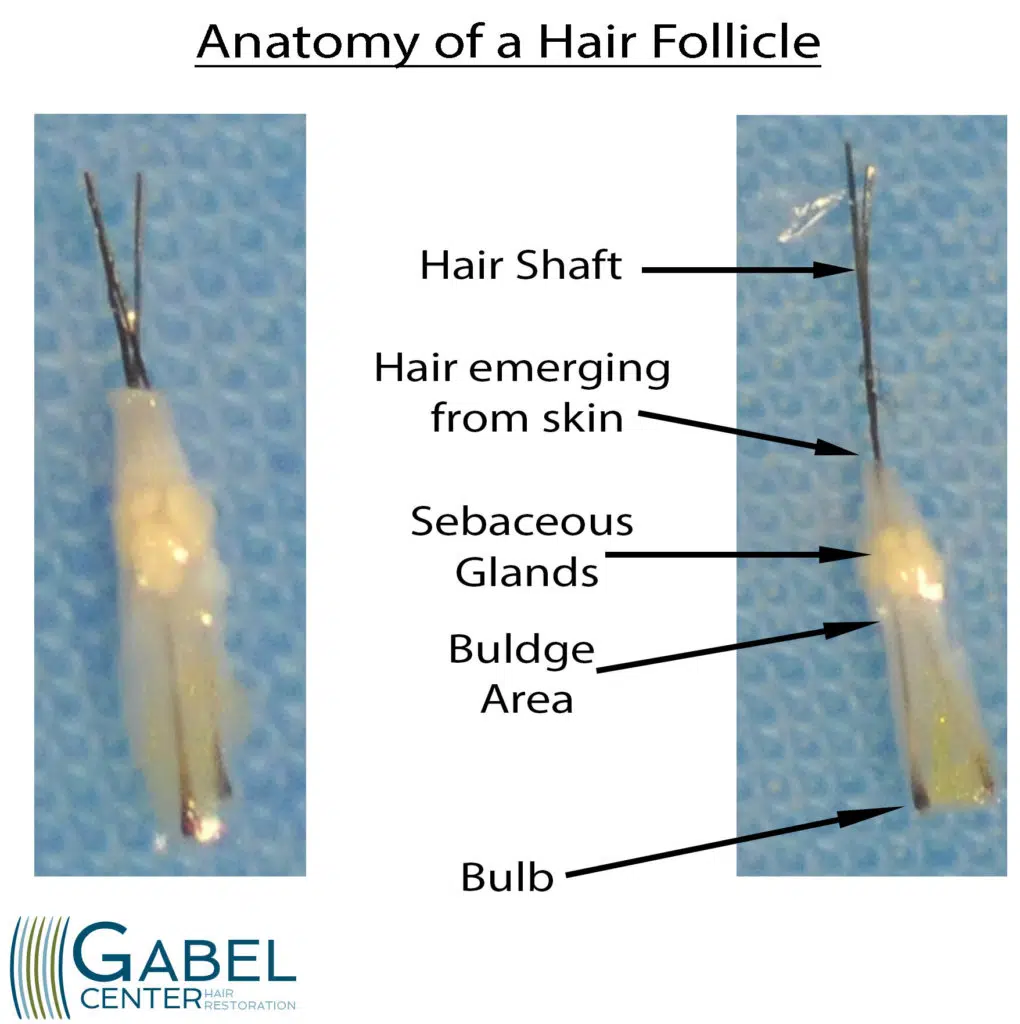The hair follicle is an organ of the body, and as simple as it looks, is quite complex. The body at birth has about 5 million hairs. The adult scalp has on average 100,000 to 125,000 hairs. There are several types of hairs throughout the body including terminal hairs and vellus hairs. This will be described in another blog post.
Hair Follicle
The photograph is a close up of a 2-hair follicular unit graft and a 3-hair follicular unit graft that were used in a hair transplant with Dr. Gabel at the Gabel Center. Starting from the top down, one sees the actual hair shaft. The hair shaft actually starts growing well beneath the skin at a region called the bulb. It starts at the bulb, and as it travels up, the hair gains its characteristics such as thickness, color, and curliness. Once the hair is at the level of the skin, it emerges and one is able to visualize the hair.

Sebaceous Glands
Just below the surface of the skin, the sebaceous glands are found. They have a slightly deeper yellow appearance because of all the surrounding fat. The sebaceous glands secrete a substance called sebum. Sebum is an oily liquid that helps to lubricate the skin and hair. One very important function of the sebaceous glands is to produce sweat. Your body produces sweat in order to help regulate the temperature in your body, as we all have experienced when warm.
The Hair Bulb
At the bottom of the hair follicle is the bulb. The bulb functions to actually make and assemble the hair shaft. It receives its own blood supply because it takes a lot of energy and substances to build the hair.
The Bulge Area
In the middle of the hair follicle is a very important structure called the bulge area, which is just below the sebaceous glands. The bulge area contains the stem cells, which are important in hair regeneration. During the normal hair cycle, the hair will grow for approximately 3 to 4 years, and is then released and a new hair is formed. The bulge area contains the cells that divide and form the new hair. Interestingly, almost all of the research in hair cell regeneration and cloning focus in the bulge region. This is the area which contains the stem cells that form new hairs. Furthermore, if scientists can figure out how to harness the stem cells in the bulge area, hair cloning one day may become a reality.
Hair Transplantation
Dr. Gabel and his team at the Gabel Center take great pride in the work they perform to help patients achieve the finest results. We use sophisticated binocular microscopes to examine and produce the best hair follicles during our patient’s hair transplant procedure. In addition, we will often show patients their actual hair follicles under the microscope and point out the structures of the hair follicle as described above. We feel it is important for our patients to actually see their hairs and understand the complexities of the hair restoration procedure.
Contact The Gabel Center
To learn more about hair loss and the latest techniques in hair restoration and hair transplant surgery, contact our hair transplant surgery center today. Our team at the Gabel Center look forward to your visit and discussing these matters with you in greater detail.
